sensor RENAULT SCENIC 2011 J95 / 3.G Engine And Peripherals EDC16 Workshop Manual
[x] Cancel search | Manufacturer: RENAULT, Model Year: 2011, Model line: SCENIC, Model: RENAULT SCENIC 2011 J95 / 3.GPages: 365, PDF Size: 2.11 MB
Page 2 of 365
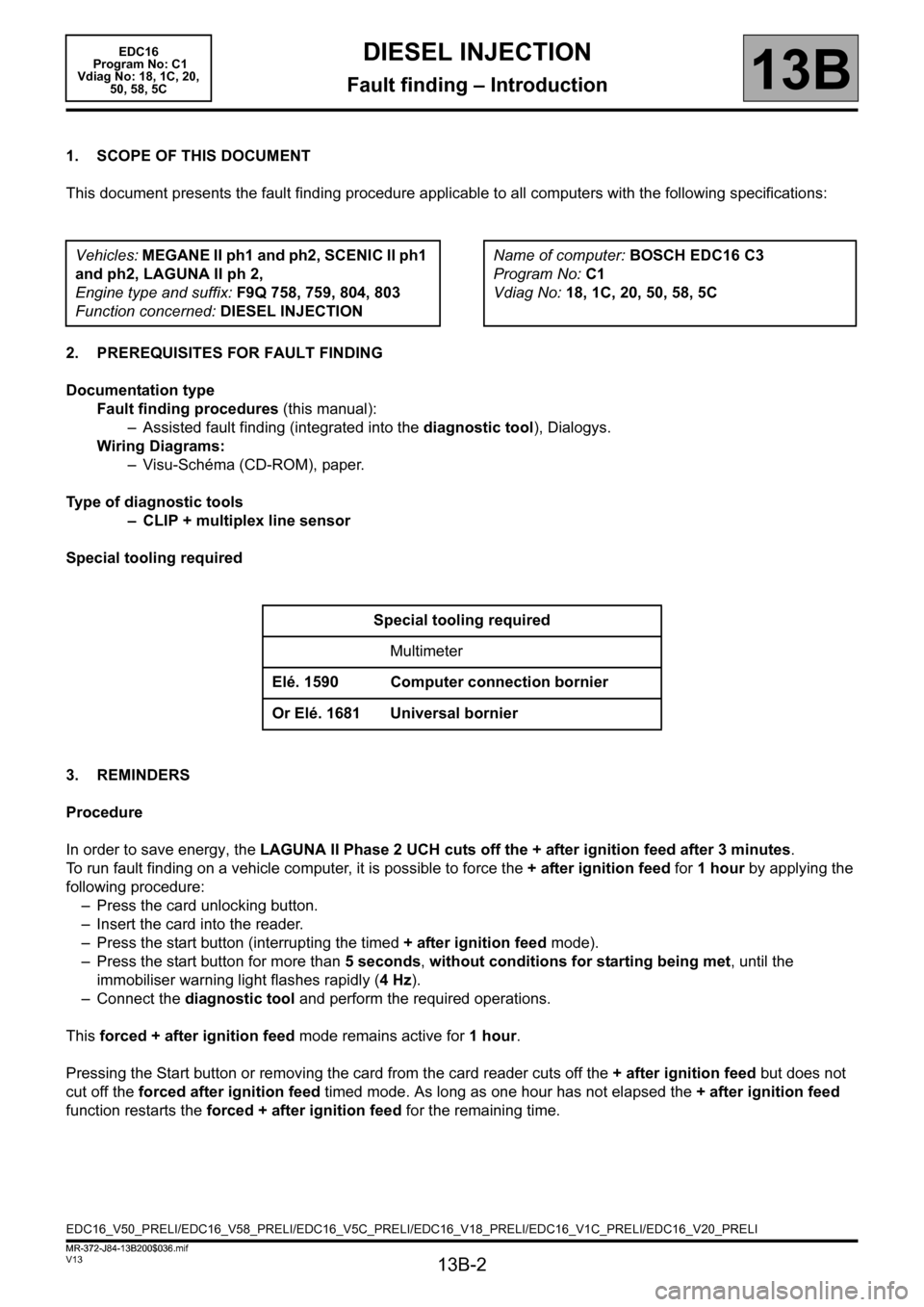
13B-2
MR-372-J84-13B200$036.mif
V13
13B
DIESEL INJECTION
Fault finding – Introduction
1. SCOPE OF THIS DOCUMENT
This document presents the fault finding procedure applicable to all computers with the following specifications:
2. PREREQUISITES FOR FAULT FINDING
Documentation type
Fault finding procedures (this manual):
– Assisted fault finding (integrated into the diagnostic tool), Dialogys.
Wiring Diagrams:
– Visu-Schéma (CD-ROM), paper.
Type of diagnostic tools
– CLIP + multiplex line sensor
Special tooling required
3. REMINDERS
Procedure
In order to save energy, the LAGUNA II Phase 2 UCH cuts off the + after ignition feed after 3 minutes.
To run fault finding on a vehicle computer, it is possible to force the + after ignition feed for 1 hour by applying the
following procedure:
– Press the card unlocking button.
– Insert the card into the reader.
– Press the start button (interrupting the timed + after ignition feed mode).
– Press the start button for more than 5 seconds, without conditions for starting being met, until the
immobiliser warning light flashes rapidly (4Hz).
– Connect the diagnostic tool and perform the required operations.
This forced + after ignition feed mode remains active for 1 hour.
Pressing the Start button or removing the card from the card reader cuts off the + after ignition feed but does not
cut off the forced after ignition feed timed mode. As long as one hour has not elapsed the + after ignition feed
function restarts the forced + after ignition feed for the remaining time. Vehicles: MEGANE II ph1 and ph2, SCENIC II ph1
and ph2, LAGUNA II ph 2,
Engine type and suffix: F9Q 758, 759, 804, 803
Function concerned: DIESEL INJECTIONName of computer: BOSCH EDC16 C3
Program No: C1
Vdiag No: 18, 1C, 20, 50, 58, 5C
Special tooling required
Multimeter
Elé. 1590 Computer connection bornier
Or Elé. 1681 Universal bornier
EDC16_V50_PRELI/EDC16_V58_PRELI/EDC16_V5C_PRELI/EDC16_V18_PRELI/EDC16_V1C_PRELI/EDC16_V20_PRELI EDC16
Program No: C1
Vdiag No: 18, 1C, 20,
50, 58, 5C
MR-372-J84-13B200$036.mif
Page 11 of 365
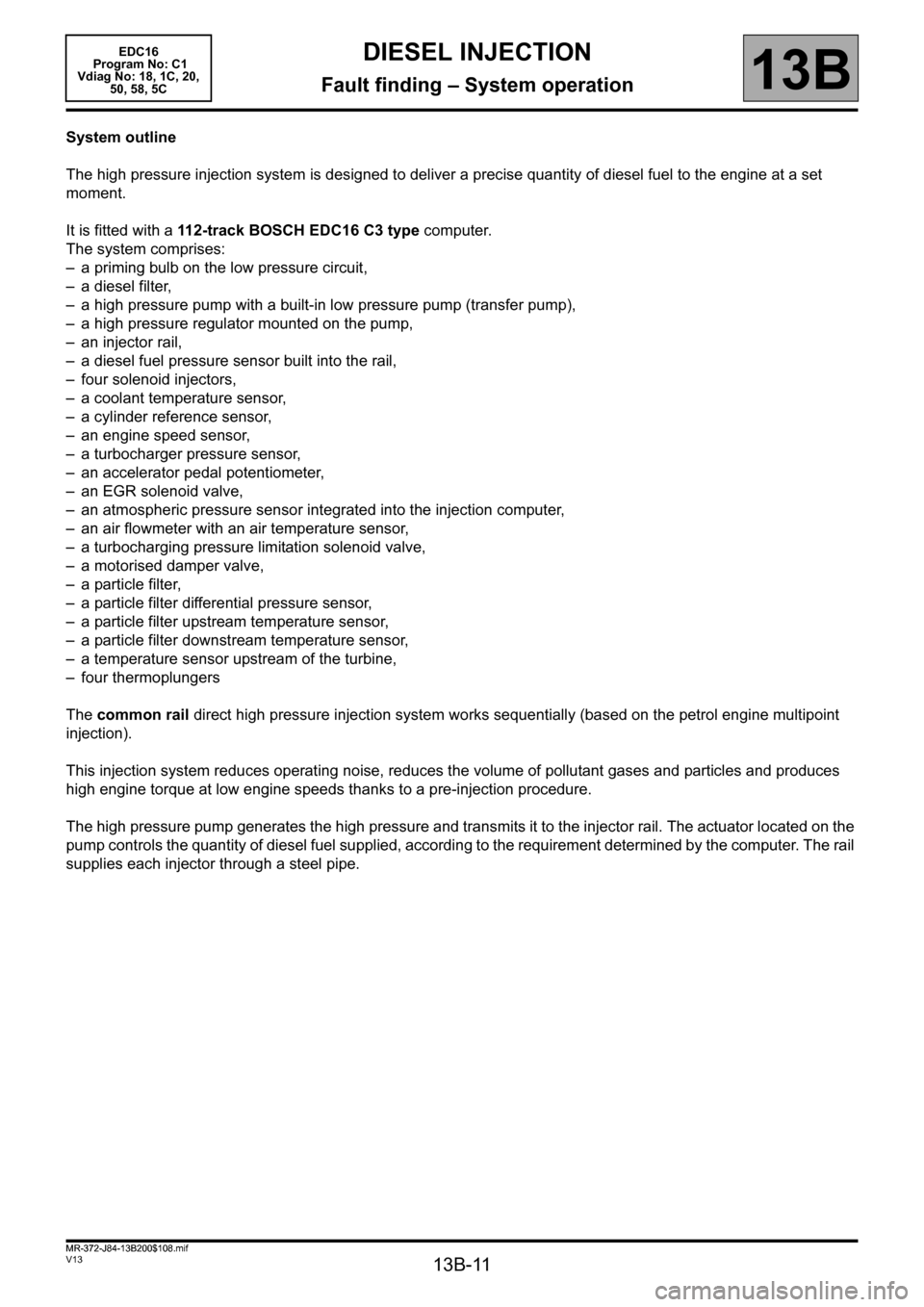
13B-11
MR-372-J84-13B200$108.mif
V13
13B
DIESEL INJECTION
Fault finding – System operation
System outline
The high pressure injection system is designed to deliver a precise quantity of diesel fuel to the engine at a set
moment.
It is fitted with a 112-track BOSCH EDC16 C3 type computer.
The system comprises:
– a priming bulb on the low pressure circuit,
– a diesel filter,
– a high pressure pump with a built-in low pressure pump (transfer pump),
– a high pressure regulator mounted on the pump,
– an injector rail,
– a diesel fuel pressure sensor built into the rail,
– four solenoid injectors,
– a coolant temperature sensor,
– a cylinder reference sensor,
– an engine speed sensor,
– a turbocharger pressure sensor,
– an accelerator pedal potentiometer,
– an EGR solenoid valve,
– an atmospheric pressure sensor integrated into the injection computer,
– an air flowmeter with an air temperature sensor,
– a turbocharging pressure limitation solenoid valve,
– a motorised damper valve,
– a particle filter,
– a particle filter differential pressure sensor,
– a particle filter upstream temperature sensor,
– a particle filter downstream temperature sensor,
– a temperature sensor upstream of the turbine,
– four thermoplungers
The common rail direct high pressure injection system works sequentially (based on the petrol engine multipoint
injection).
This injection system reduces operating noise, reduces the volume of pollutant gases and particles and produces
high engine torque at low engine speeds thanks to a pre-injection procedure.
The high pressure pump generates the high pressure and transmits it to the injector rail. The actuator located on the
pump controls the quantity of diesel fuel supplied, according to the requirement determined by the computer. The rail
supplies each injector through a steel pipe.
MR-372-J84-13B200$108.mif
EDC16
Program No: C1
Vdiag No: 18, 1C, 20,
50, 58, 5C
Page 12 of 365
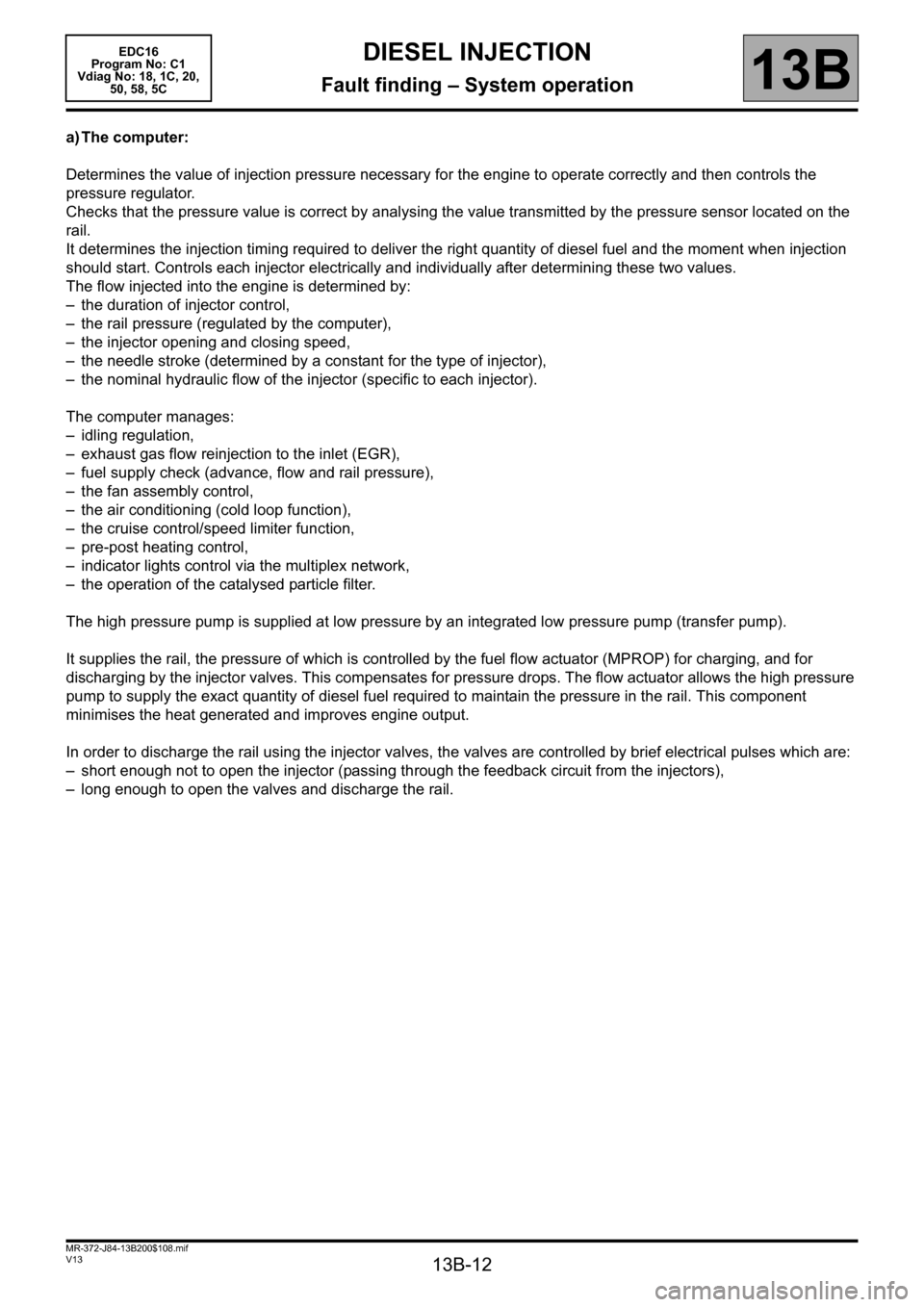
13B-12
MR-372-J84-13B200$108.mif
V13
DIESEL INJECTION
Fault finding – System operation
EDC16
Program No: C1
Vdiag No: 18, 1C, 20,
50, 58, 5C
13B
a) The computer:
Determines the value of injection pressure necessary for the engine to operate correctly and then controls the
pressure regulator.
Checks that the pressure value is correct by analysing the value transmitted by the pressure sensor located on the
rail.
It determines the injection timing required to deliver the right quantity of diesel fuel and the moment when injection
should start. Controls each injector electrically and individually after determining these two values.
The flow injected into the engine is determined by:
– the duration of injector control,
– the rail pressure (regulated by the computer),
– the injector opening and closing speed,
– the needle stroke (determined by a constant for the type of injector),
– the nominal hydraulic flow of the injector (specific to each injector).
The computer manages:
– idling regulation,
– exhaust gas flow reinjection to the inlet (EGR),
– fuel supply check (advance, flow and rail pressure),
– the fan assembly control,
– the air conditioning (cold loop function),
– the cruise control/speed limiter function,
– pre-post heating control,
– indicator lights control via the multiplex network,
– the operation of the catalysed particle filter.
The high pressure pump is supplied at low pressure by an integrated low pressure pump (transfer pump).
It supplies the rail, the pressure of which is controlled by the fuel flow actuator (MPROP) for charging, and for
discharging by the injector valves. This compensates for pressure drops. The flow actuator allows the high pressure
pump to supply the exact quantity of diesel fuel required to maintain the pressure in the rail. This component
minimises the heat generated and improves engine output.
In order to discharge the rail using the injector valves, the valves are controlled by brief electrical pulses which are:
– short enough not to open the injector (passing through the feedback circuit from the injectors),
– long enough to open the valves and discharge the rail.
Page 13 of 365
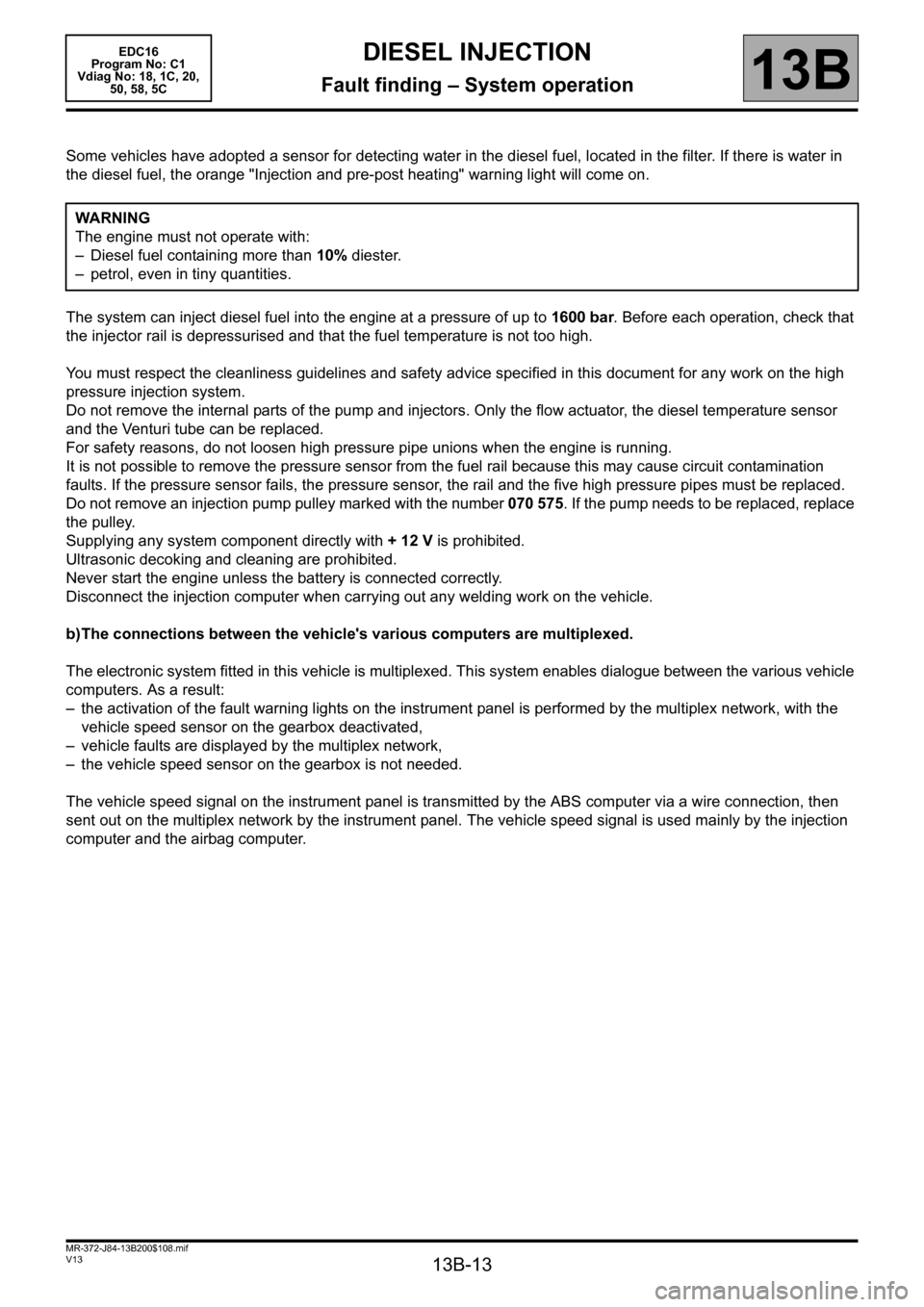
13B-13
MR-372-J84-13B200$108.mif
V13
DIESEL INJECTION
Fault finding – System operation
EDC16
Program No: C1
Vdiag No: 18, 1C, 20,
50, 58, 5C
13B
Some vehicles have adopted a sensor for detecting water in the diesel fuel, located in the filter. If there is water in
the diesel fuel, the orange "Injection and pre-post heating" warning light will come on.
The system can inject diesel fuel into the engine at a pressure of up to 1600 bar. Before each operation, check that
the injector rail is depressurised and that the fuel temperature is not too high.
You must respect the cleanliness guidelines and safety advice specified in this document for any work on the high
pressure injection system.
Do not remove the internal parts of the pump and injectors. Only the flow actuator, the diesel temperature sensor
and the Venturi tube can be replaced.
For safety reasons, do not loosen high pressure pipe unions when the engine is running.
It is not possible to remove the pressure sensor from the fuel rail because this may cause circuit contamination
faults. If the pressure sensor fails, the pressure sensor, the rail and the five high pressure pipes must be replaced.
Do not remove an injection pump pulley marked with the number 070 575. If the pump needs to be replaced, replace
the pulley.
Supplying any system component directly with +12V is prohibited.
Ultrasonic decoking and cleaning are prohibited.
Never start the engine unless the battery is connected correctly.
Disconnect the injection computer when carrying out any welding work on the vehicle.
b)The connections between the vehicle's various computers are multiplexed.
The electronic system fitted in this vehicle is multiplexed. This system enables dialogue between the various vehicle
computers. As a result:
– the activation of the fault warning lights on the instrument panel is performed by the multiplex network, with the
vehicle speed sensor on the gearbox deactivated,
– vehicle faults are displayed by the multiplex network,
– the vehicle speed sensor on the gearbox is not needed.
The vehicle speed signal on the instrument panel is transmitted by the ABS computer via a wire connection, then
sent out on the multiplex network by the instrument panel. The vehicle speed signal is used mainly by the injection
computer and the airbag computer.WARNING
The engine must not operate with:
– Diesel fuel containing more than 10% diester.
– petrol, even in tiny quantities.
Page 16 of 365
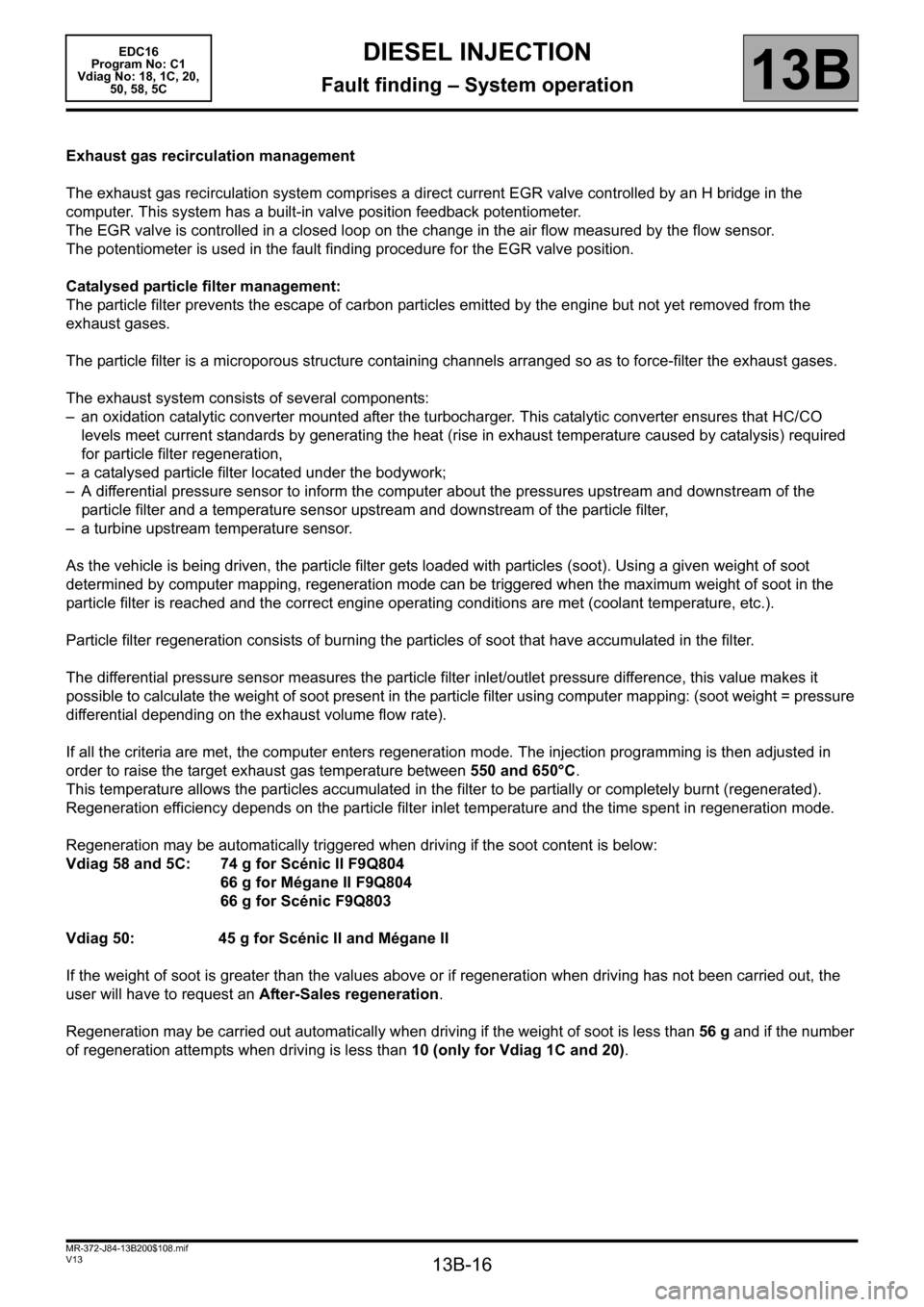
13B-16
MR-372-J84-13B200$108.mif
V13
DIESEL INJECTION
Fault finding – System operation
EDC16
Program No: C1
Vdiag No: 18, 1C, 20,
50, 58, 5C
13B
Exhaust gas recirculation management
The exhaust gas recirculation system comprises a direct current EGR valve controlled by an H bridge in the
computer. This system has a built-in valve position feedback potentiometer.
The EGR valve is controlled in a closed loop on the change in the air flow measured by the flow sensor.
The potentiometer is used in the fault finding procedure for the EGR valve position.
Catalysed particle filter management:
The particle filter prevents the escape of carbon particles emitted by the engine but not yet removed from the
exhaust gases.
The particle filter is a microporous structure containing channels arranged so as to force-filter the exhaust gases.
The exhaust system consists of several components:
– an oxidation catalytic converter mounted after the turbocharger. This catalytic converter ensures that HC/CO
levels meet current standards by generating the heat (rise in exhaust temperature caused by catalysis) required
for particle filter regeneration,
– a catalysed particle filter located under the bodywork;
– A differential pressure sensor to inform the computer about the pressures upstream and downstream of the
particle filter and a temperature sensor upstream and downstream of the particle filter,
– a turbine upstream temperature sensor.
As the vehicle is being driven, the particle filter gets loaded with particles (soot). Using a given weight of soot
determined by computer mapping, regeneration mode can be triggered when the maximum weight of soot in the
particle filter is reached and the correct engine operating conditions are met (coolant temperature, etc.).
Particle filter regeneration consists of burning the particles of soot that have accumulated in the filter.
The differential pressure sensor measures the particle filter inlet/outlet pressure difference, this value makes it
possible to calculate the weight of soot present in the particle filter using computer mapping: (soot weight = pressure
differential depending on the exhaust volume flow rate).
If all the criteria are met, the computer enters regeneration mode. The injection programming is then adjusted in
order to raise the target exhaust gas temperature between 550 and 650°C.
This temperature allows the particles accumulated in the filter to be partially or completely burnt (regenerated).
Regeneration efficiency depends on the particle filter inlet temperature and the time spent in regeneration mode.
Regeneration may be automatically triggered when driving if the soot content is below:
Vdiag 58 and 5C: 74 g for Scénic II F9Q804
66 g for Mégane II F9Q804
66 g for Scénic F9Q803
Vdiag 50: 45 g for Scénic II and Mégane II
If the weight of soot is greater than the values above or if regeneration when driving has not been carried out, the
user will have to request an After-Sales regeneration.
Regeneration may be carried out automatically when driving if the weight of soot is less than 56 g and if the number
of regeneration attempts when driving is less than 10 (only for Vdiag 1C and 20).
Page 20 of 365
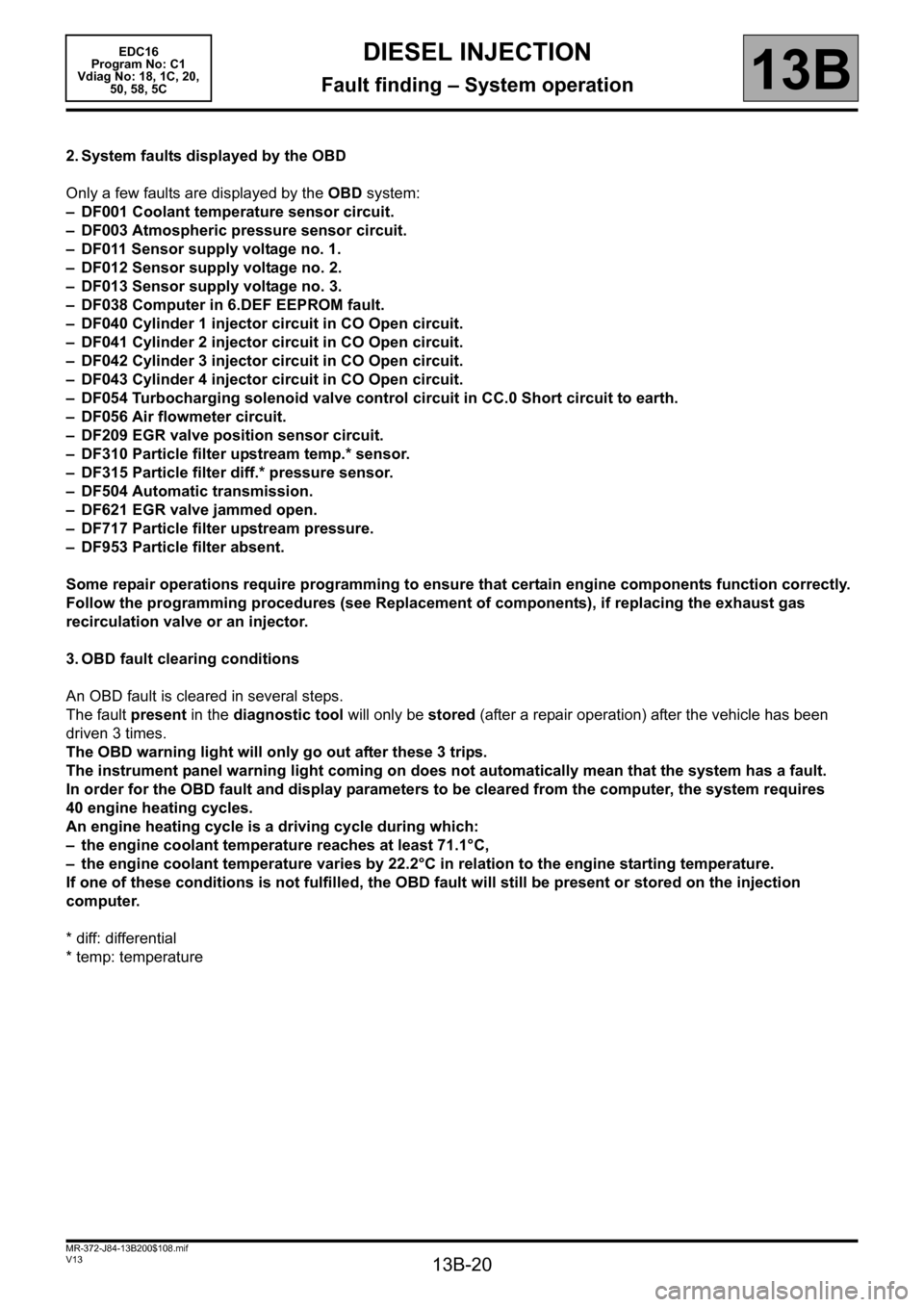
13B-20
MR-372-J84-13B200$108.mif
V13
DIESEL INJECTION
Fault finding – System operation
EDC16
Program No: C1
Vdiag No: 18, 1C, 20,
50, 58, 5C
13B
2. System faults displayed by the OBD
Only a few faults are displayed by the OBD system:
– DF001 Coolant temperature sensor circuit.
– DF003 Atmospheric pressure sensor circuit.
– DF011 Sensor supply voltage no. 1.
– DF012 Sensor supply voltage no. 2.
– DF013 Sensor supply voltage no. 3.
– DF038 Computer in 6.DEF EEPROM fault.
– DF040 Cylinder 1 injector circuit in CO Open circuit.
– DF041 Cylinder 2 injector circuit in CO Open circuit.
– DF042 Cylinder 3 injector circuit in CO Open circuit.
– DF043 Cylinder 4 injector circuit in CO Open circuit.
– DF054 Turbocharging solenoid valve control circuit in CC.0 Short circuit to earth.
– DF056 Air flowmeter circuit.
– DF209 EGR valve position sensor circuit.
– DF310 Particle filter upstream temp.* sensor.
– DF315 Particle filter diff.* pressure sensor.
– DF504 Automatic transmission.
– DF621 EGR valve jammed open.
– DF717 Particle filter upstream pressure.
– DF953 Particle filter absent.
Some repair operations require programming to ensure that certain engine components function correctly.
Follow the programming procedures (see Replacement of components), if replacing the exhaust gas
recirculation valve or an injector.
3. OBD fault clearing conditions
An OBD fault is cleared in several steps.
The fault present in the diagnostic tool will only be stored (after a repair operation) after the vehicle has been
driven 3 times.
The OBD warning light will only go out after these 3 trips.
The instrument panel warning light coming on does not automatically mean that the system has a fault.
In order for the OBD fault and display parameters to be cleared from the computer, the system requires
40 engine heating cycles.
An engine heating cycle is a driving cycle during which:
– the engine coolant temperature reaches at least 71.1°C,
– the engine coolant temperature varies by 22.2°C in relation to the engine starting temperature.
If one of these conditions is not fulfilled, the OBD fault will still be present or stored on the injection
computer.
* diff: differential
* temp: temperature
Page 26 of 365
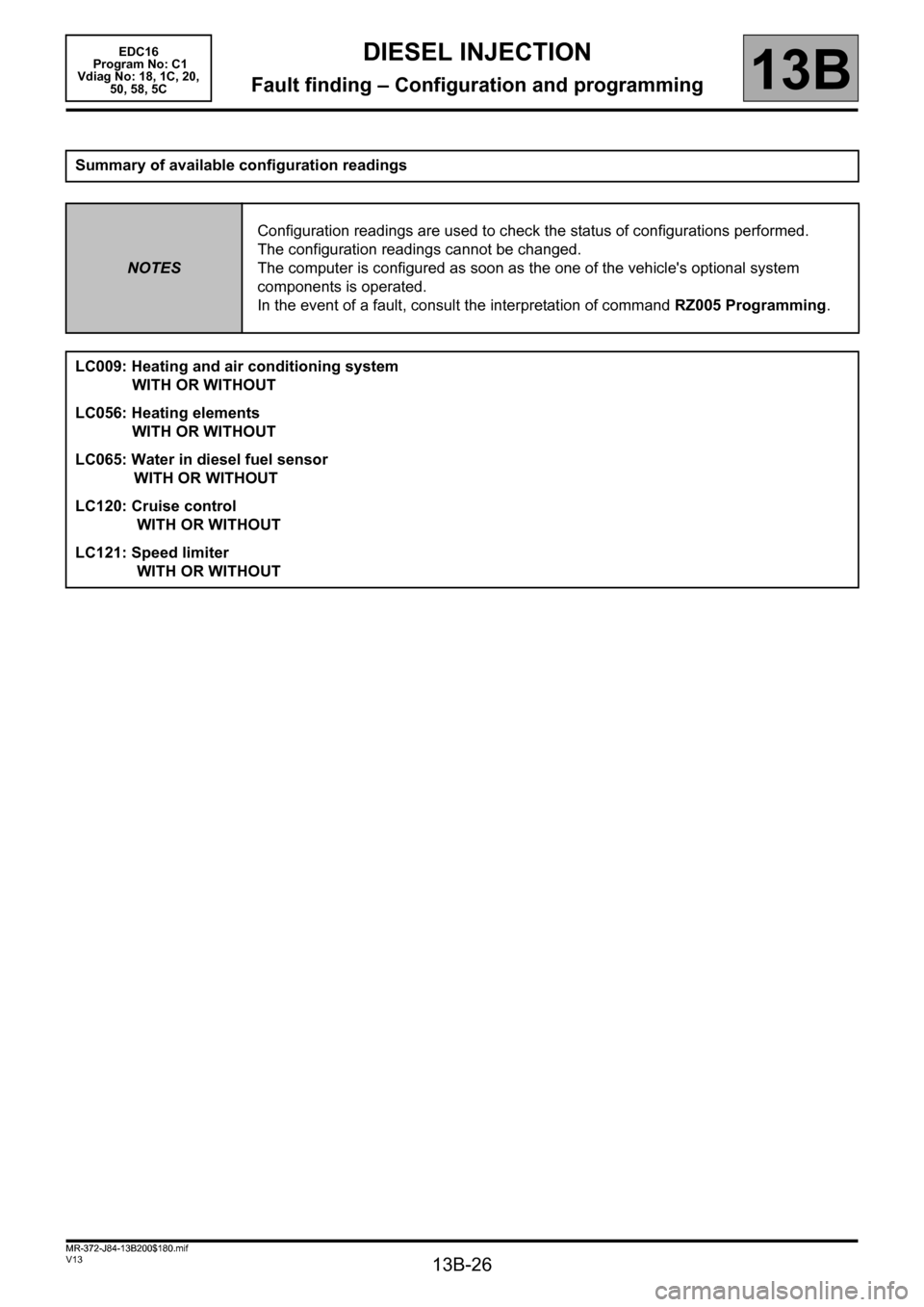
13B-26
MR-372-J84-13B200$180.mif
V13
13B
DIESEL INJECTION
Fault finding – Configuration and programming
Summary of available configuration readings
NOTESConfiguration readings are used to check the status of configurations performed.
The configuration readings cannot be changed.
The computer is configured as soon as the one of the vehicle's optional system
components is operated.
In the event of a fault, consult the interpretation of command RZ005 Programming.
LC009: Heating and air conditioning system
WITH OR WITHOUT
LC056: Heating elements
WITH OR WITHOUT
LC065: Water in diesel fuel sensor
WITH OR WITHOUT
LC120: Cruise control
WITH OR WITHOUT
LC121: Speed limiter
WITH OR WITHOUT
EDC16
Program No: C1
Vdiag No: 18, 1C, 20,
50, 58, 5C
MR-372-J84-13B200$180.mif
Page 27 of 365
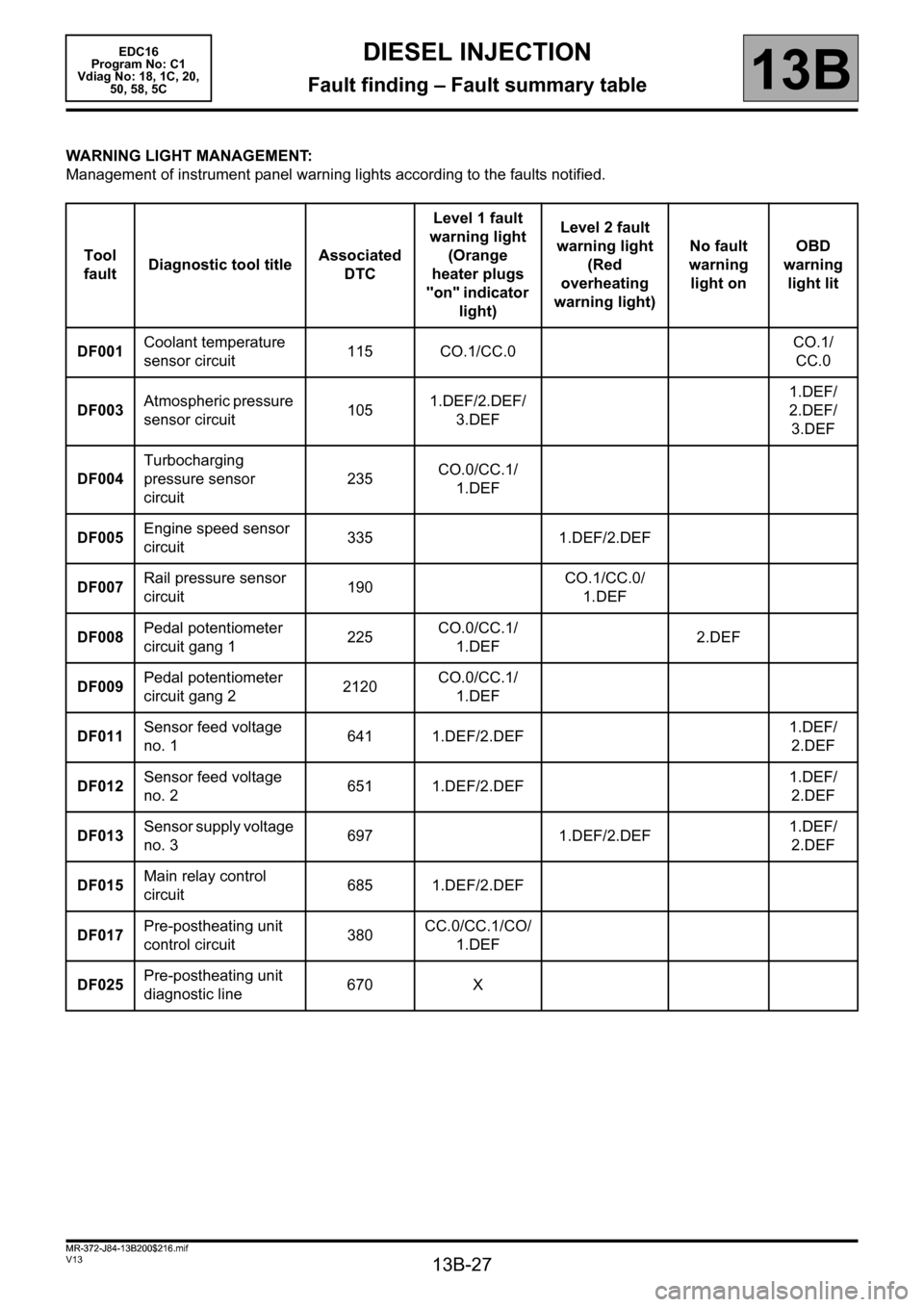
13B-27
MR-372-J84-13B200$216.mif
V13
13B
DIESEL INJECTION
Fault finding – Fault summary table
WARNING LIGHT MANAGEMENT:
Management of instrument panel warning lights according to the faults notified.
Tool
faultDiagnostic tool titleAssociated
DTCLevel 1 fault
warning light
(Orange
heater plugs
"on" indicator
light)Level 2 fault
warning light
(Red
overheating
warning light)No fault
warning
light onOBD
warning
light lit
DF001Coolant temperature
sensor circuit115 CO.1/CC.0CO.1/
CC.0
DF003Atmospheric pressure
sensor circuit1051.DEF/2.DEF/
3.DEF1.DEF/
2.DEF/
3.DEF
DF004Turbocharging
pressure sensor
circuit235CO.0/CC.1/
1.DEF
DF005Engine speed sensor
circuit335 1.DEF/2.DEF
DF007Rail pressure sensor
circuit190CO.1/CC.0/
1.DEF
DF008Pedal potentiometer
circuit gang 1225CO.0/CC.1/
1.DEF2.DEF
DF009Pedal potentiometer
circuit gang 22120CO.0/CC.1/
1.DEF
DF011Sensor feed voltage
no. 1641 1.DEF/2.DEF1.DEF/
2.DEF
DF012Sensor feed voltage
no. 2651 1.DEF/2.DEF1.DEF/
2.DEF
DF013Sensor supply voltage
no. 3697 1.DEF/2.DEF1.DEF/
2.DEF
DF015Main relay control
circuit685 1.DEF/2.DEF
DF017Pre-postheating unit
control circuit380CC.0/CC.1/CO/
1.DEF
DF025Pre-postheating unit
diagnostic line670 X
EDC16
Program No: C1
Vdiag No: 18, 1C, 20,
50, 58, 5C
MR-372-J84-13B200$216.mif
Page 28 of 365
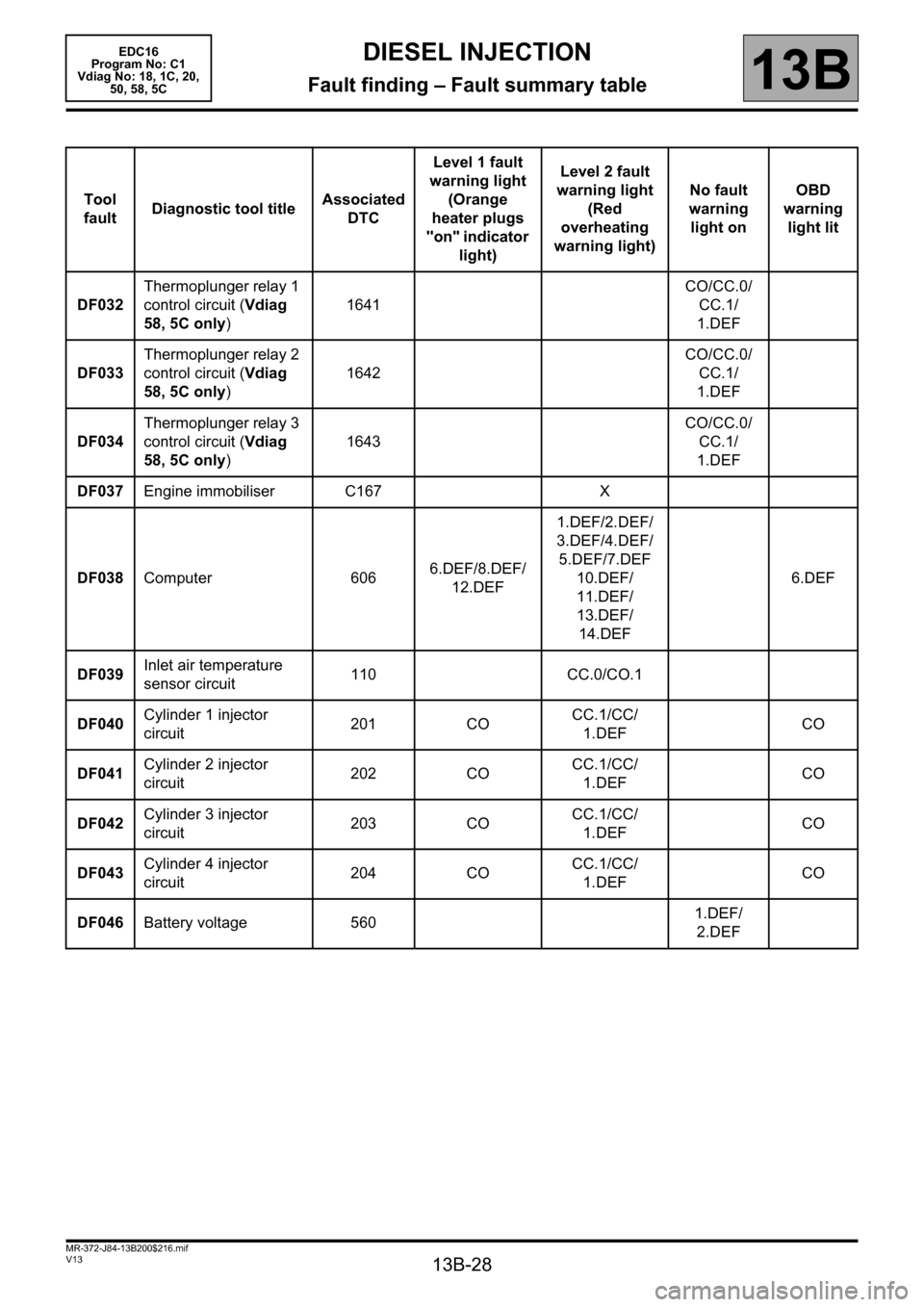
13B-28
MR-372-J84-13B200$216.mif
V13
DIESEL INJECTION
Fault finding – Fault summary table
EDC16
Program No: C1
Vdiag No: 18, 1C, 20,
50, 58, 5C
13B
Tool
faultDiagnostic tool titleAssociated
DTCLevel 1 fault
warning light
(Orange
heater plugs
"on" indicator
light)Level 2 fault
warning light
(Red
overheating
warning light)No fault
warning
light onOBD
warning
light lit
DF032Thermoplunger relay 1
control circuit (Vdiag
58, 5C only)1641CO/CC.0/
CC.1/
1.DEF
DF033Thermoplunger relay 2
control circuit (Vdiag
58, 5C only)1642CO/CC.0/
CC.1/
1.DEF
DF034Thermoplunger relay 3
control circuit (Vdiag
58, 5C only)1643CO/CC.0/
CC.1/
1.DEF
DF037Engine immobiliser C167 X
DF038Computer 6066.DEF/8.DEF/
12.DEF1.DEF/2.DEF/
3.DEF/4.DEF/
5.DEF/7.DEF
10.DEF/
11.DEF/
13.DEF/
14.DEF6.DEF
DF039Inlet air temperature
sensor circuit110 CC.0/CO.1
DF040Cylinder 1 injector
circuit201 COCC.1/CC/
1.DEFCO
DF041Cylinder 2 injector
circuit202 COCC.1/CC/
1.DEFCO
DF042Cylinder 3 injector
circuit203 COCC.1/CC/
1.DEFCO
DF043Cylinder 4 injector
circuit204 COCC.1/CC/
1.DEFCO
DF046Battery voltage 5601.DEF/
2.DEF
Page 29 of 365

13B-29
MR-372-J84-13B200$216.mif
V13
DIESEL INJECTION
Fault finding – Fault summary table
EDC16
Program No: C1
Vdiag No: 18, 1C, 20,
50, 58, 5C
13B
Tool
faultDiagnostic tool titleAssociated
DTCLevel 1 fault
warning light
(Orange
heater plugs
"on" indicator
light)Level 2 fault
warning light
(Red
overheating
warning light)No fault
warning
light onOBD
warning
light lit
DF047Computer feed voltage 615 1.DEF
DF049Refrigerant sensor
circuit530 CC.1/CO.0
DF050Brake switch circuit 5711.DEF/
2.DEF
DF051Cruise control/speed
limiter function5751.DEF/
2.DEF/
3.DEF
DF053Rail pressure
regulation function89 3.DEFCC.0/CC.1/CO/
1.DEF/2.DEF/
4.DEF/5.DEF/
6.DEF/7.DEF
DF054Turbocharging
solenoid valve control
circuit33CO/CC.0/CC.1/
1.DEF/
2.DEF/3.DEF
4.DEF/5.DEFCC.0
DF055Turbocharging
pressure regulation
circuit243 1.DEF/2.DEF
DF056Air flow sensor circuit 100CO.0/CC.1/
1.DEF/2.DEFCO.0/
CC.1/
1.DEF/
2.DEF
DF057Water in diesel fuel
detector circuit2264 X
DF058Oil temperature sensor
circuit195CC.0/
CO.1
DF059Misfiring on cylinder 1 301 X
DF060Misfiring on cylinder 2 302 X